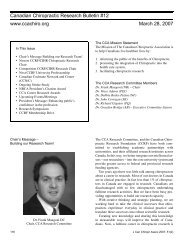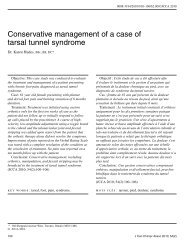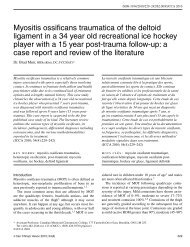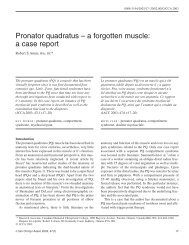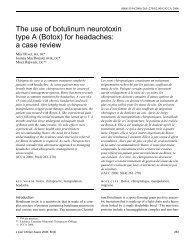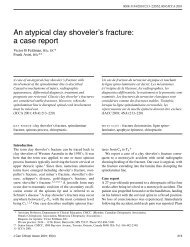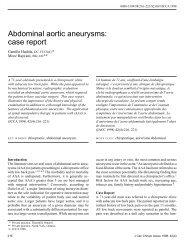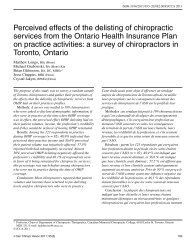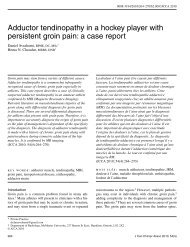The Tampa Scale of Kinesiophobia and neck pain, disability and ...
The Tampa Scale of Kinesiophobia and neck pain, disability and ...
The Tampa Scale of Kinesiophobia and neck pain, disability and ...
You also want an ePaper? Increase the reach of your titles
YUMPU automatically turns print PDFs into web optimized ePapers that Google loves.
K HudesTroup <strong>and</strong> Bentley which attempts to “explain how <strong>and</strong>why some individuals develop a more significant psychologicaloverlay than others do.” 1, 2 <strong>The</strong> model explains thatavoidance <strong>of</strong> <strong>pain</strong> because <strong>of</strong> fear <strong>and</strong> the avoidance <strong>of</strong><strong>pain</strong>ful activities (cognitive <strong>and</strong> behavioural avoidance)lead to physical <strong>and</strong> psychological consequences. 1 Thismodel has been widely used <strong>and</strong> supported.<strong>Kinesiophobia</strong> is a term that was introduced by Miller,Kori <strong>and</strong> Todd in 1990 at the Ninth Annual ScientificMeeting <strong>of</strong> the American Pain Society <strong>and</strong> describesa situation where “a patient has an excessive, irrational,<strong>and</strong> debilitating fear <strong>of</strong> physical movement <strong>and</strong> activityresulting from a feeling <strong>of</strong> vulnerability to <strong>pain</strong>ful injuryor reinjury.” 1,3 <strong>The</strong> <strong>Tampa</strong> <strong>Scale</strong> for <strong>Kinesiophobia</strong> (TSK)is a 17 item questionnaire used to assess the subjectiverating <strong>of</strong> kinesiophobia or fear <strong>of</strong> movement. 1,4,5 <strong>The</strong> originalquestionnaire was developed to “discriminate betweennon-excessive fear <strong>and</strong> phobia among patients withchronic musculoskeletal <strong>pain</strong>.” 3,4 Several studies havefound the scale to be a valid <strong>and</strong> reliable psychometricmeasure. 1,4,5 Initially used to measure fear <strong>of</strong> movementrelated to chronic low back <strong>pain</strong>, the TSK has been usedincreasingly for <strong>pain</strong> related to different body parts includingthe cervical spine. 6 <strong>The</strong> TSK is a self-completedquestionnaire <strong>and</strong> the range <strong>of</strong> scores are from 17 to 68where the higher scores indicate an increasing degree <strong>of</strong>kinesiophobia. 6Initial research has concluded that the fear avoidancemodel may be predictive after acute whiplash injury regardingthe transition to chronic whiplash symptoms. 7For the practitioner who regularly treats patients withthis type <strong>of</strong> injury, it would be helpful to identify specific,easy <strong>and</strong> inexpensive tools to use to identify patients whoare at higher risk <strong>of</strong> developing chronic symptoms <strong>and</strong>kinesiophobia. <strong>The</strong> purpose <strong>of</strong> this narrative review <strong>of</strong>the literature was to review, <strong>and</strong> summarize the literatureregarding the use <strong>of</strong> the <strong>Tampa</strong> <strong>Scale</strong> <strong>of</strong> <strong>Kinesiophobia</strong><strong>and</strong> its relationship to <strong>neck</strong> <strong>pain</strong>, perceived <strong>disability</strong> <strong>and</strong>range <strong>of</strong> motion <strong>of</strong> the cervical spine.MethodsAn initial search was performed on July 13, 2010 <strong>of</strong>Medline, MANTIS <strong>and</strong> the Index to Chiropractic Literature(ICL). CINAHL was searched on August 17,2010 <strong>and</strong> these databases were searched for a secondtime to determine if the searches yielded any new articles.<strong>The</strong> following MeSH terms were used in the CIN-AHL, Medline <strong>and</strong> ICL searches: “Pain Measurement,”“Questionnaires,” “Severity <strong>of</strong> Illness Index,” “<strong>pain</strong> <strong>and</strong>Psychology,” “Avoidance Learning,” “Fear/Psychology,”“Neck Injuries,” “Neck Pain,” <strong>and</strong> “Cervical Vertebrae.”<strong>The</strong> following keywords were also used: “<strong>Tampa</strong> <strong>Scale</strong> <strong>of</strong><strong>Kinesiophobia</strong>.” <strong>The</strong> only limiter used was English Languageonly articles in the searches.ResultsNumerous studies were identified regarding the TSK <strong>and</strong>musculoskeletal <strong>pain</strong>. Far fewer were found regardingTSK in relation specifically to cervical spine <strong>pain</strong>. A total<strong>of</strong> 16 studies, including one review <strong>of</strong> the literature, werefound using these inclusion criteria. <strong>The</strong>se studies fell int<strong>of</strong>our distinct categories. <strong>The</strong> first category was TSK <strong>and</strong><strong>neck</strong> <strong>pain</strong> which includes a total <strong>of</strong> 4 studies includingthe review mentioned above spanning from 2006 through2008. <strong>The</strong> second category is TSK, <strong>neck</strong> <strong>pain</strong> <strong>and</strong> <strong>disability</strong>(using the Neck Disability Index (NDI) or other measure)<strong>and</strong> includes 10 studies spanning 2004 through 2009.<strong>The</strong> last two categories are TSK, <strong>neck</strong> <strong>pain</strong>, <strong>disability</strong> <strong>and</strong>strength <strong>and</strong> TSK, <strong>neck</strong> <strong>pain</strong> <strong>and</strong> surface EMG, each <strong>of</strong>which include one study in 2009 <strong>and</strong> 2006 respectively.DiscussionEach <strong>of</strong> the 16 studies identified are discussed <strong>and</strong> summarizedbelow (Table 1).TSK <strong>and</strong> Neck Pain<strong>The</strong> first study in this section <strong>and</strong> one <strong>of</strong> the first studiesusing the TSK on <strong>neck</strong> <strong>pain</strong> patients was conductedby Buitenhuis, Jaspers <strong>and</strong> Fidler <strong>and</strong> published in 2006. 8Using the Dutch version <strong>of</strong> the TSK (TSK-DV) this oneyear prospective cohort study sent out 889 questionnairesto whiplash sufferers with <strong>neck</strong> symptoms from motorvehicle accidents from a Dutch insurance company. Sixtysixpercent <strong>of</strong> the studies were returned <strong>and</strong> 367 were usedfor analysis. <strong>The</strong> purpose <strong>of</strong> the study was to investigatethe “predictive value <strong>of</strong> early kinesiophobia on the duration<strong>of</strong> <strong>neck</strong> symptoms after a motor vehicle accident.” 8It was found that a higher score on the TSK-DV was associatedwith longer duration <strong>of</strong> <strong>neck</strong> symptoms but thatinformation on “early kinesiophobia does not improveprediction <strong>of</strong> duration <strong>of</strong> <strong>neck</strong> symptoms after a motorvehicle accident.” 8 Although this was the conclusion forJ Can Chiropr Assoc 2011; 55(3) 223
<strong>The</strong> <strong>Tampa</strong> <strong>Scale</strong> <strong>of</strong> <strong>Kinesiophobia</strong> <strong>and</strong> <strong>neck</strong> <strong>pain</strong>, <strong>disability</strong> <strong>and</strong> range <strong>of</strong> motion: a narrative review <strong>of</strong> the literatureTable 1 Study summaryStudy reference number(#),Publication date <strong>and</strong>Authors Sample size Type <strong>of</strong> Study Objective Results <strong>and</strong> conclusion Limitations(6)September 2009Pool et. al.13 Inception cohort withbaseline assessmentTo determine the applicability <strong>of</strong> the TSKto <strong>neck</strong> <strong>pain</strong>– Supports the use <strong>of</strong> the fearavoidance model for <strong>neck</strong> <strong>pain</strong>– use <strong>of</strong> the ‘think aloud’ method to fillin questionnaire may confound results(7)2007Vangronsveld et. al.N/A Topical review Review <strong>of</strong> a few studies that investigatedthe applying the fear avoidance model tochronic whiplash syndrome– Supports the use <strong>of</strong> the fearavoidance model for <strong>neck</strong> <strong>pain</strong>– narrow focus <strong>of</strong> topical reviewregarding the use <strong>of</strong> the fear avoidancemodel for <strong>neck</strong> <strong>pain</strong>.(8)March/April 2006Buitenhuis et. al.367 Questionnaire investigate the “predictive value <strong>of</strong> earlykinesiophobia on the duration <strong>of</strong> <strong>neck</strong>symptoms after a motor vehicle accident– Higher TSK scores predictedincreased symptom duration.– Early <strong>Kinesiophobia</strong> does notimprove symptom prediction– used mailed questionnaires thereforeno control over situation in whichquestionnaire was completed.– participants contacted through insurer(MVA) which may influence scoring onquestionnaires.(9)November 2007Feleus et. al.679 Prospective cohort “determine if mean scores <strong>of</strong>kinesiophobia change over time” inthose patients that they considered ‘nonrecovered’– Unrecovered subjects do notexhibit changing TSK scores overtime– no previous reports <strong>of</strong> value <strong>of</strong> TSK<strong>and</strong> <strong>neck</strong>, shoulder <strong>and</strong> arm <strong>pain</strong>.– number <strong>of</strong> variables may confoundstudy results.(10)March 2004Nederh<strong>and</strong> et. al.82 ProspectivelongitudinalInvestigate if fear avoidance variablesincrease prediction <strong>of</strong> chronic <strong>neck</strong> <strong>pain</strong>– <strong>The</strong> use <strong>of</strong> the NDI along withTSK can predict future <strong>neck</strong> <strong>pain</strong>outcomes– recruitment method <strong>and</strong> facility <strong>of</strong>research may cause selection bias <strong>and</strong>/or symptom magnification.(11)2005Sterling et. al.80 Determine predictive capacity <strong>of</strong> the TSKmeasured early at long term follow up.– Higher NDI scores (withdecreased ROM (9)) <strong>and</strong> increasedpsychological distress/PTSD canpredict the persistence <strong>of</strong> symptoms/poor outcomes– recruitment method may causeselection bias <strong>and</strong>/or symptommagnification.– first study <strong>of</strong> its kind therefore resultshave yet to be confirmed.(12)2006Bunketorp et. al.47 RCT To determine the effect <strong>of</strong> individualizedsupervised physical training vs. homeself exercise on patients with subacutewhiplash– Self efficacy is an important factorin persistent <strong>neck</strong> <strong>pain</strong> <strong>disability</strong>– differences in exercise programsto supervised patients may exist asdifferent practitioners were used whichmay confound results.– Blinding not possible on patients ortreating physiotherapists which mayproduce bias– increased contact with treatingphysiotherapists in supervised groupwould increase level <strong>of</strong> patienteducation <strong>and</strong> may confound results.(13)March 2006Buketorp et. al.49 RCT To analyze the effects on <strong>disability</strong><strong>of</strong> subacute whiplash patients fromthe different factors <strong>of</strong> <strong>pain</strong>(sensory,cognitive, affective)– Self efficacy is an important factorin persistent <strong>neck</strong> <strong>pain</strong> <strong>disability</strong>– differences in exercise programsto supervised patients may exist asdifferent practitioners were used whichmay confound results.– Blinding not possible on patients ortreating physiotherapists which mayproduce bias– increased contact with treatingphysiotherapists in supervised groupwould increase level <strong>of</strong> patienteducation <strong>and</strong> may confound results.– unclear if patients matched appropriatelyin consideration <strong>of</strong> this study224 J Can Chiropr Assoc 2011; 55(3)
K HudesTable 1 (Concluded)Study referencesnumber(#), Publicationdate <strong>and</strong> Author Sample size Type <strong>of</strong> Study Objective Results <strong>and</strong> conclusion Limitations(14)2006Sterling et. al.80 ProspectivelongitudinalAnalyze the predictive capacity <strong>of</strong> higherlevels <strong>of</strong> certain variables (older age, <strong>pain</strong>,<strong>disability</strong>, cold hyperalgisa, impairedsympathetic vasoconstriction <strong>and</strong>moderate PTSD symptoms) at long termfollow up <strong>of</strong> whiplash injury.– Higher NDI scores (withdecreased ROM (9)) <strong>and</strong> increasedpsychological distress/PTSD canpredict the persistence <strong>of</strong> symptoms/poor outcomes– recruitment method <strong>and</strong> facility <strong>of</strong>research may cause selection bias <strong>and</strong>/or symptom magnification.– unknown if findings can beextrapolated to other populations(15)February 2008Clel<strong>and</strong> et. al.78 Cohort Determine the value <strong>of</strong> using the FABQ<strong>and</strong> TSK in <strong>neck</strong> <strong>pain</strong> patients– Supports the use <strong>of</strong> the fearavoidance model for <strong>neck</strong> <strong>pain</strong>– recruitment method <strong>and</strong> facility <strong>of</strong>research may cause selection bias <strong>and</strong>/or symptom magnification.– test-retesting may have been done tooclose together promoting bias.(16)2006Gustavsson, C <strong>and</strong> vonKoch, L.37 RCT To examine the usefulness <strong>of</strong> thisparticular study design (RCT) inevaluating patients with long term <strong>neck</strong><strong>pain</strong> <strong>and</strong> compare the effects <strong>of</strong> treatment.– Applied relaxation group hadbetter perceived control over <strong>pain</strong>– Self efficacy is an important factorin persistent <strong>neck</strong> <strong>pain</strong> <strong>disability</strong>– preliminary study therefore smallsample size(17)May 2008De Loose et. al.629 Questionnaire (crosssectional)Estimate the prevalence <strong>and</strong> identify riskfactors <strong>of</strong> <strong>neck</strong> <strong>pain</strong> in military <strong>of</strong>ficeworkers– <strong>neck</strong> <strong>pain</strong> is prevalent in military<strong>of</strong>fice workers <strong>and</strong> psychosocialfactors are more important in theshort term– used mailed questionnaires thereforeno control over situation in whichquestionnaire was completed.– population may have a reluctance toadmit to <strong>pain</strong> <strong>and</strong> <strong>disability</strong>/fear.(18)2009Nieto et. al.147 Questionnaire Identify if fear <strong>of</strong> movement <strong>and</strong> <strong>pain</strong>catastrophizing predict <strong>disability</strong> <strong>and</strong>depression in subacute whiplash patients.– Supports the use <strong>of</strong> the fearavoidance model for <strong>neck</strong> <strong>pain</strong>– recruitment method <strong>and</strong> facility <strong>of</strong>research may cause selection bias <strong>and</strong>/or symptom magnification.– long term follow up needed.(19)2009Vernon et. al.107 Cross sectional design Used chronic whiplash patients todetermine if fear avoidance behaviour<strong>and</strong> <strong>pain</strong> amplification along withseveral factors (age, gender, duration <strong>and</strong><strong>pain</strong> severity) correlate with perceived<strong>disability</strong>.– Supports the use <strong>of</strong> the fearavoidance model for <strong>neck</strong> <strong>pain</strong>– focused on chronic <strong>neck</strong> <strong>pain</strong> <strong>and</strong>subjects entered study after referral forthird party specialist assessment whichmay produce selection bias.(20)March 2009Pearson et. al.14 WAD28 healthypatientsCross sectionalrepeated measuresdesignTo determine if there is a link between<strong>neck</strong> strength measurements <strong>and</strong> <strong>pain</strong>,kinesiophobia <strong>and</strong> castastrophizing inWAD patients– No significant association wasfound between TSK/NDI <strong>and</strong> <strong>neck</strong>strength– 3 <strong>of</strong> 6 muscles tested in chronicWAD showed decreased strengthcompared to healthy subjects.– recruitment method <strong>and</strong> facility <strong>of</strong>research may cause selection bias <strong>and</strong>/or symptom magnification.– most WAD sufferers were in driver’sside collisions which may produce biasto which muscles affected(21)August 2006Nederh<strong>and</strong> et. al.92 Prospectivelongitudinal designTo determine the influence <strong>of</strong> <strong>pain</strong> <strong>and</strong>fear <strong>of</strong> movement on activation patterns<strong>of</strong> the upper trapezius muscle during thetransition from acute to chronic <strong>neck</strong> <strong>pain</strong>– Supports the use <strong>of</strong> the fearavoidance model for <strong>neck</strong> <strong>pain</strong>– Supports the use <strong>of</strong> the <strong>pain</strong>adaptation model for <strong>neck</strong> <strong>pain</strong>– use <strong>of</strong> sEMG which is currentlyclassified as an experimental assessmenttechnique by the American Academy <strong>of</strong>Neurologists.– recruitment method <strong>and</strong> facility <strong>of</strong>research may cause selection bias <strong>and</strong>/or symptom magnification.J Can Chiropr Assoc 2011; 55(3) 225
<strong>The</strong> <strong>Tampa</strong> <strong>Scale</strong> <strong>of</strong> <strong>Kinesiophobia</strong> <strong>and</strong> <strong>neck</strong> <strong>pain</strong>, <strong>disability</strong> <strong>and</strong> range <strong>of</strong> motion: a narrative review <strong>of</strong> the literaturethe study, it was noted that a relationship does exist betweenthe TSK score <strong>and</strong> the duration <strong>of</strong> <strong>neck</strong> symptoms.However, when other variables were accounted for suchas sex <strong>and</strong> age, the significance was lost. <strong>The</strong>se variableshave been previously shown to have a relationship to <strong>neck</strong><strong>pain</strong> duration. 8 It was also noted that there was a relationshipbetween TSK score <strong>and</strong> symptom intensity as well asdifficulty with concentration <strong>and</strong> initiation <strong>of</strong> sleep. Thisstudy utilized mailed questionnaires to victims <strong>of</strong> motorvehicle accidents <strong>and</strong> were contacted through a Dutch insurancecompany. Although the authors maintain that itwas made clear on the letter <strong>of</strong> invitation to the study thatinvolvement would be independent <strong>of</strong> compensation fromthe insurer regarding the claim, one cannot be sure thatsymptom exaggeration was not present in responses. Inaddition, as the study was mailed, the authors identifiedthat there was no control <strong>of</strong> the environment under whichthe questionnaires were completed.In 2007, Feleus, van Dalen, Bierma-Zeinstra, Bernsen,Verhaar, Koes <strong>and</strong> Miedema used a prospective cohort designto describe the degree <strong>of</strong> kinesiophobia in patientswith non-traumatic complaints <strong>of</strong> arm, <strong>neck</strong> <strong>and</strong> shoulderin general practice. 9 <strong>The</strong> study used the 13 item adjustedDutch version <strong>of</strong> the TSK (TSK-AV). <strong>The</strong> aim wasto “determine if mean scores <strong>of</strong> kinesiophobia changeover time” in those patients that they considered “non-recovered.”9 Additionally they sought to evaluate variablesincluding age, gender, educational level, work, sports participation,duration <strong>of</strong> complaint, severity <strong>of</strong> complaint, aswell as psychosocial characteristics <strong>and</strong> their associationwith kinesiophobia at baseline. <strong>The</strong> category <strong>of</strong> recurrentcomplaint was also included <strong>and</strong> accounted for not onlyrecurrent complaints, but also multiple complaints <strong>and</strong>complaint location. <strong>The</strong> study evaluated 36 patients witha new complaint or episode <strong>of</strong> <strong>neck</strong>, upper back, shoulder,upper arm, elbow, forearm, wrist or h<strong>and</strong> <strong>pain</strong> aged18 to 64 years. Excluded from the study were those with<strong>pain</strong> that could be explained. <strong>The</strong> patients completed aninitial questionnaire <strong>and</strong> then again at 6 <strong>and</strong> 12 month followup. It was found that the degree <strong>of</strong> kinesiophobia wasunchanged in patients who did not recover during the 12month follow up. Limitations include the lack <strong>of</strong> previousreports <strong>of</strong> the psychometric value <strong>of</strong> the TSK with respectto <strong>neck</strong>, shoulder <strong>and</strong> arm <strong>pain</strong>, the lack <strong>of</strong> measurement<strong>of</strong> depression in the patients <strong>and</strong> the use <strong>of</strong> one question togive an indication <strong>of</strong> “health locus <strong>of</strong> control.” Relationshipswere noted between baseline scores <strong>of</strong> kinesiophobia<strong>and</strong> catastrophizing, <strong>disability</strong> <strong>and</strong> other musculoskeletalcomplaints/comorbilities. This said, it was noted that thismade it unclear if the origin <strong>of</strong> kinesiophobia was rootedin the other comorbilities (low back <strong>pain</strong>) or a previousbad experience. Although the authors reported that thesecomorbilities did not modify the association, the highnumber <strong>of</strong> variables in this study could have confoundedresults. In addition, the study was not limited to <strong>neck</strong> <strong>pain</strong>only patients <strong>and</strong> included patients with arm <strong>and</strong> shouldercomplaints. This could artificially inflate relationships betweenkinesiophobia <strong>and</strong> <strong>neck</strong> <strong>pain</strong> as patients frequentlyhave difficulty separating these types <strong>of</strong> symptoms <strong>and</strong>their effects.In 2007 Vangronsveld, Peters, Goossens, Linton <strong>and</strong>Vlaeyen published a topical review “Applying the fearavoidancemodel to the chronic whiplash syndrome.” 7 Thisreview sought to review what the authors considered to berelevant studies that examined whether the fear avoidancemodel can be applied to chronic whiplash syndrome. All<strong>of</strong> the studies examined in this review will be examined indetail in this paper. It was concluded that the fear avoidancemodel “may <strong>of</strong>fer a novel framework to explain thetransition from acute whiplash injury to chronic whiplashsyndrome.” 7 It was suggested that future research shouldinclude multiple outcome measures as patients who sufferan acute whiplash not only are at risk <strong>of</strong> developing high<strong>pain</strong> levels <strong>and</strong> <strong>disability</strong> but also mood disorders <strong>and</strong> posttraumatic stress disorder. Suggestions for future researchinclude determining if high levels <strong>of</strong> catastrophizing soonafter a whiplash injury lead to more complaints at finalfollow up, as well as studying other potential predictors(anxiety sensitivity <strong>and</strong> acute traumatic stress symptoms).This review included only a few studies as it was a topicalreview. <strong>The</strong> limitation is primarily that by its nature, atopical review provides a small window into the research.Pool, Hiralal, Ostelo, van der Veer, Vlaeyen, Bouter<strong>and</strong> de Vet published a study regarding “<strong>The</strong> applicability<strong>of</strong> the <strong>Tampa</strong> <strong>Scale</strong> <strong>of</strong> <strong>Kinesiophobia</strong> for patientswith sub-acute <strong>neck</strong> <strong>pain</strong>” in 2009. 6 This study sought to“qualitatively evaluate patients” underst<strong>and</strong>ing <strong>and</strong> interpretation<strong>of</strong> the wording in test items <strong>of</strong> the TSK” whichwas initially developed to measure fear <strong>of</strong> movement <strong>of</strong>patients suffering from low back <strong>pain</strong>. It attempted toelicit or discover problems that patients with sub-acute<strong>neck</strong> <strong>pain</strong> may have in filling out the TSK . Thirteen226 J Can Chiropr Assoc 2011; 55(3)
K Hudespatients (7 women <strong>and</strong> 6 men) aged 18 to 70 were evaluatedusing the Three-Step Test Interview (TSTI) which aims toidentify problems with self-administered questionnaires.It was reported that two problems were identified includingthe use <strong>and</strong> meaning <strong>of</strong> specific words such as “dangerous”<strong>and</strong> “injury” as well as that implicit assumptionswithin some items make it difficult for some respondentsto answer these questions. <strong>The</strong> authors concluded that inthe “development <strong>and</strong> validation <strong>of</strong> questionnaires such asthe TSK not only qualitative psychometric properties areimportant, but also qualitative research has an importantcontribution to enhance applicability.” 6 Questionnaires inthis study were filled out using a “think aloud” methodwhich the authors reported proved difficult for some participants.By its nature, this method may cause participantsto become uncomfortable if they feel they are beingjudged by the study investigators which may influencetheir verbalizations. It was reported that some participantsanswered quickly while others did so slowly but it wasnot reported if any specific participant characteristic (age,gender) was related to this.TSK, Neck Pain <strong>and</strong> DisabilityIn 2004 Nederh<strong>and</strong>, IJzerman, Hermens, Turk <strong>and</strong> Zilvoldattempted to determine the “Predictive value <strong>of</strong> fearAvoidance in developing chronic <strong>neck</strong> <strong>pain</strong> <strong>disability</strong>.” 10Using an inception cohort design with a baseline assessmentone week post trauma <strong>and</strong> outcome assessment at24 weeks post trauma, the purpose <strong>of</strong> this study was toimprove clinical decision making in patients with posttraumatic <strong>neck</strong> <strong>pain</strong> by investigating fear avoidance inpredicting <strong>neck</strong> <strong>pain</strong> <strong>disability</strong>. 10 Ninety-one percent <strong>of</strong>the 90 participants between the ages <strong>of</strong> 18 <strong>and</strong> 70 in thestudy completed the follow up outcome. It was found thatby using a combination <strong>of</strong> baseline NDI <strong>and</strong> TSK scoresit was possible to predict chronic <strong>disability</strong> with a probability<strong>of</strong> 54.2% after using NDI alone <strong>and</strong> 83.3% whenusing a combination <strong>of</strong> NDI <strong>and</strong> TSK scores. <strong>The</strong> authorsconcluded that a “rating <strong>of</strong> <strong>neck</strong> <strong>pain</strong> <strong>disability</strong> within aweek <strong>of</strong> trauma used separately or in combination witha test for fear <strong>of</strong> movement can be used to predict futureoutcomes.” 10 This finding is opposite to the first study discussedabove by Buitenhuis in 2006. However, unlike thepreviously discussed study this study excluded patientswith neurologic signs <strong>and</strong> focused on head <strong>and</strong> <strong>neck</strong><strong>pain</strong> alone. Limitations <strong>of</strong> this study include recruitmentmethod (patients admitted to the emergency department<strong>of</strong> a hospital) <strong>and</strong> the fact that the study was conducted ata well known rehabilitation <strong>and</strong> research facility. <strong>The</strong>secharacteristics may well lend to symptom magnification<strong>and</strong>/or have a tendency towards selection bias <strong>of</strong> thosemore prone to catastrophizing or symptom magnification.In 2004, Sterling, Jull, Vicenzino, Kenardy <strong>and</strong> Darnellinvestigated “physical <strong>and</strong> psychological factors(that) predict outcome following whiplash injury.’ 11 Thisprospective longitudinal designed study investigated 80patients with a mean age <strong>of</strong> 36.27+/–12.69 years that reported<strong>neck</strong> <strong>pain</strong> as a result <strong>of</strong> a motor vehicle accident.<strong>The</strong> purpose <strong>of</strong> this study was to determine the predictivecapacity <strong>of</strong> the combined comprehensive set <strong>of</strong> measuresthat included motor, sensory <strong>and</strong> psychological measuresencompassing the broad biopsychosocial model <strong>of</strong> musculoskeletal<strong>pain</strong>. Measures used included motor functioning(range <strong>of</strong> motion, kinesthetic sense, <strong>and</strong> activity <strong>of</strong>superficial <strong>neck</strong> flexors on EMG), sensory testing, vasoconstrictorresponses, psychological distress (includingvarious measures along with the TSK) <strong>and</strong> the NDI. <strong>The</strong>outcome measure was persistent <strong>pain</strong> at six months postinjury. It was concluded that “higher NDI scores, greaterpsychological distress <strong>and</strong> decreased range <strong>of</strong> motionpredicted subjects with persistent milder symptoms fromthose who fully recovered.” 11 <strong>The</strong> authors suggested thatboth “physical <strong>and</strong> psychological factors play a role inrecovery or non-recovery from whiplash injury.” 11 Whena combination <strong>of</strong> the variables was used, the predictivevalue was better than when compared to previous modelsthat did not use all <strong>of</strong> these variables. <strong>The</strong> authors reportedthat they could account for 67% <strong>of</strong> the variationin <strong>pain</strong> <strong>and</strong> <strong>disability</strong> using this model compared to 35%when using a combination <strong>of</strong> age, gender, psychologicalfactors or age, gender <strong>and</strong> accident features. As this studywas the first <strong>of</strong> its kind, that being the first to show thatphysical <strong>and</strong> psychological factors when added to previouslyknown factors (age <strong>and</strong> initial symptom intensity)are important in predicting outcomes <strong>of</strong> whiplash injuries,confirmation <strong>of</strong> results are needed. Interestingly, higher<strong>pain</strong> reports were predicted by cervical range <strong>of</strong> motionloss. This was the only motor function that predicted longterm outcomes while EMG activity in flexion <strong>of</strong> the cervicalspine <strong>and</strong> joint position error were not isolated toonly WAD sufferers with higher level <strong>of</strong> <strong>pain</strong> symptoms.<strong>The</strong> limitation for this study is similar to that <strong>of</strong> the studyJ Can Chiropr Assoc 2011; 55(3) 227
<strong>The</strong> <strong>Tampa</strong> <strong>Scale</strong> <strong>of</strong> <strong>Kinesiophobia</strong> <strong>and</strong> <strong>neck</strong> <strong>pain</strong>, <strong>disability</strong> <strong>and</strong> range <strong>of</strong> motion: a narrative review <strong>of</strong> the literaturepublished in 2004 by Nederh<strong>and</strong> et. al. above as patientswere recruited following a motor vehicle accident in hospitalemergency rooms; however, this effect is lessenedas people were also recruited from primary care practice,<strong>and</strong> advertisement.Bunketorp, Lindh, Carlsson <strong>and</strong> Stener-Victorin firstused the results <strong>of</strong> their r<strong>and</strong>omized controlled trial using40 subjects in a publication in 2005. 12 <strong>The</strong> purpose <strong>of</strong> thestudy was to evaluate if a tailored <strong>and</strong> supervised physicaltraining program had a greater influence on self efficacy,fear <strong>of</strong> movement <strong>and</strong> re-injury than a self administeredhome exercise program. <strong>The</strong> study used the Self Efficacy<strong>Scale</strong> <strong>and</strong> the TSK as primary measures <strong>and</strong> thePain Disability Index as a secondary measure. It was reportedthat the supervised training was significantly moreeffective than the home training program” with a morerapid improvement in self efficacy <strong>and</strong> fear <strong>of</strong> movementat three months <strong>and</strong> that the results were partially maintainedat nine months.” This was the only study elicitedin the literature search that measured the outcomes <strong>of</strong>treatment with the TSK for <strong>neck</strong> <strong>pain</strong>. Improvement inkinesiophobia, perceived <strong>disability</strong> due to <strong>pain</strong>, self efficacy<strong>and</strong> analgesic use was noted to be significant in thegroup that received a tailored supervised exercise programcompared to the home exercise group. Although theinvestigator performing measurements was blinded to thegroup the patient was in, due to the nature <strong>of</strong> the study, thefive treating physiotherapists <strong>and</strong> the patients could notbe blinded which may have influenced outcomes. As fivedifferent physiotherapists were used to provide treatment,<strong>and</strong> the group getting tailored treatment each had differentprograms, it is unclear if each patient in the supervisedtraining group was provided with equally effective programs.In addition, the added contact between the supervisedgroup <strong>and</strong> physiotherapists would provide increasededucation levels to these patients as it would be near impossiblefor the practitioner not to continue to educate thepatients. It is therefore a confounding factor as it cannotbe definitively said that the exercise program differencesaccount for the significant differences in groups as patienteducation would also be a likely factor in the differencesseen.In 2006, the same investigators (Bunketorp et. al.) usedthe data collected in for their 2005 study to “clarify relationsbetween sensory, affective <strong>and</strong> cognitive dimensions<strong>of</strong> <strong>pain</strong> <strong>and</strong> to analyze what influence these componentshave on persistent <strong>disability</strong> in patients with sub-acutewhiplash associated disorder.” 13 It was reported that “selfefficacy was the most important predictor <strong>of</strong> persistent<strong>disability</strong>.” 13 Additionally the following factors werefound to correspond to lower self efficacy: high <strong>pain</strong> intensity<strong>and</strong> <strong>pain</strong> affect, widespread <strong>pain</strong> <strong>and</strong> fear <strong>of</strong> movement.As the same data was used as in the previous study,it begs the question were the investigators planning thiscomponent <strong>of</strong> the research prior to the investigation or didthey use existing data because a relationship was noted.If the latter is the case, bias may be present as the groupsmay not have been matched effectively to investigate thisportion <strong>of</strong> the research. In addition, all <strong>of</strong> the same limitationslisted above would also apply to this study.<strong>The</strong> predictive value <strong>of</strong> variables including initialhigher levels <strong>of</strong> <strong>pain</strong> <strong>and</strong> <strong>disability</strong>, older age, cold hyperalgesia,impaired sympathetic vasoconstriction <strong>and</strong> moderatepost-traumatic stress symptoms were investigated ina study published in 2006 by Sterling, Jull <strong>and</strong> Kenardy. 14<strong>The</strong> investigators noted that while these variables havebeen shown to be associated with poor outcomes at 6months post whiplash, investigation <strong>of</strong> associations at longterm follow up was lacking. This study used a prospectivelongitudinal design to follow <strong>and</strong> assess 80 acute whiplashpatients to 2, 3, <strong>and</strong> 6 months post injury <strong>and</strong> againat 2–3 years post injury. <strong>The</strong> study employed the TSK <strong>and</strong>NDI as well as cervical range <strong>of</strong> motion, joint positionerror, pressure <strong>pain</strong> <strong>and</strong> thermal thresholds <strong>and</strong> measures<strong>of</strong> the sympathetic nervous system function (sympatheticvasoconstrictor response). It was concluded that “higherinitial NDI scores, older age, cold hyperalgesia <strong>and</strong> posttraumatic stress symptoms were significant predictors <strong>of</strong>poor outcome at long term follow up” 14 When the TSKalong with Impact <strong>of</strong> Events <strong>Scale</strong> <strong>and</strong> the General HealthQuestionnaire 28 were used it was found that there wasa “significant group effect for the group with moderate/severe symptoms at 2–3 years when compared to groupswith milder symptoms.” 14 As it was noted that the physical<strong>and</strong> psychological characteristics <strong>of</strong> those who did notrecover at 6 months <strong>and</strong> long term follow up were presentat one month post injury, it was implied that this posessignificant implications for early management <strong>of</strong> this type<strong>of</strong> patient. <strong>The</strong> authors suggest that this group <strong>of</strong> patientsmay benefit from early multidisciplinary management toinclude adequate <strong>pain</strong> control using pharmacotherapy,physical <strong>and</strong> psychological therapy. Subjects were re-228 J Can Chiropr Assoc 2011; 55(3)
K Hudescruited from emergency departments following a motorvehicle accident (as well as their primary care physicians<strong>and</strong> advertisements) which may produce a bias towardsthose with symptom magnification. It was reported by theauthors that the findings in a small group <strong>of</strong> whiplash patientsmay not extrapolate to exp<strong>and</strong> to other populations.In 2008 Clel<strong>and</strong>, Fritz <strong>and</strong> Childs attempted to examine“the psychometric properties <strong>of</strong> the Fear Avoidance BeliefsQuestionnaire (FABQ) <strong>and</strong> the TSK in Patients with<strong>neck</strong> <strong>pain</strong>.” 15 Using a cohort design, 78 subjects wereasked to complete the Fear Avoidance Beliefs QuestionnaireWork (FABQW) <strong>and</strong> Physical Activity (FABQPA)as well as the TSK at baseline <strong>and</strong> 2 day follow up. Itwas reported that “the FABQW <strong>and</strong> FABQPA had subsettest-retest reliability <strong>and</strong> the TSK was moderately reliablefor <strong>neck</strong> <strong>pain</strong> patients.” 15 Consistency was found forall measures. <strong>The</strong> authors concluded that this study suggesteda “weaker relationship between measures <strong>of</strong> fear<strong>and</strong> avoidance <strong>and</strong> <strong>pain</strong>/<strong>disability</strong> in patients with mechanical<strong>neck</strong> <strong>pain</strong> than has been reported among patientswith lower back <strong>pain</strong>.” 15 <strong>The</strong> authors identified limitations<strong>of</strong> the study including the inclusion <strong>of</strong> sub-acute <strong>neck</strong> <strong>pain</strong>patients which they felt may have influenced the results aswell as the fact that the dimensionality <strong>of</strong> the scales werenot assessed. This factor affects the statistical tool theyused (Cronbach’s alpha), which they felt may account forlower TSK scores in comparison to the other measuresthey used. It was also noted that subjects included wereconsecutive patients presenting to a hospital physiotherapydepartment with history <strong>of</strong> a whiplash injury within6 weeks. This may present a bias towards patients withsymptom magnification. <strong>The</strong> follow up testing was doneonly 2 days following initial testing which may not proveto be a significant enough amount <strong>of</strong> time between testsas patients may have a tendency to recall what they scoredonly two days prior. It would be interesting to have repeatedthis measure a more significant amount <strong>of</strong> timelater such as one to three months.Gustavsson <strong>and</strong> von Koch used measures <strong>of</strong> <strong>neck</strong> <strong>pain</strong>,TSK <strong>and</strong> NDI to “evaluate the feasibility <strong>of</strong> study design<strong>and</strong> method for evaluating effects <strong>of</strong> interventionson patients with long lasting <strong>neck</strong> <strong>pain</strong> <strong>and</strong> to comparethe treatment effects <strong>of</strong> (i) a <strong>pain</strong> <strong>and</strong> stress managementgroup intervention with applied relaxation <strong>and</strong> (ii)individual physiotherapy treatment as usual.” 16 Using ar<strong>and</strong>omized controlled pilot study, the authors evaluated37 patients with long lasting <strong>neck</strong> <strong>pain</strong>. Patients wereassigned to either an applied relaxation group which received7 group sessions over 7 weeks or the “as usual”group who had an average <strong>of</strong> 11 physiotherapy sessionsover 20 weeks. Using the NDI, Coping Strategies Questionnaire,Hospital Anxiety <strong>and</strong> Depression <strong>Scale</strong>, TSK<strong>and</strong> questions regarding <strong>neck</strong> <strong>pain</strong>, analgesic use, sleep,sick leave <strong>and</strong> health care utilization, it was found thatthe applied relaxation group had “better perceived control<strong>of</strong> <strong>pain</strong>” at 20 week follow up compared to the “asusual” group. <strong>The</strong> authors concluded that “this design <strong>and</strong>methods would be suitable for a larger RCT study.” 16 <strong>The</strong>limitations <strong>of</strong> this study is that <strong>of</strong> its preliminary nature<strong>and</strong> small sample size for each group.In 2008 De Loose, Burnotte, Cagnie, Stevens, VanTiggelen <strong>and</strong> Defense used a cross sectional questionnairestudy <strong>of</strong> 942 <strong>of</strong>fice workers <strong>of</strong> the Belgian Defenseto attempt to identify short <strong>and</strong> long term risk factors inthe occurrence <strong>of</strong> <strong>neck</strong> <strong>pain</strong> in military <strong>of</strong>fice workers. 17Using the NDI <strong>and</strong> TSK to assess the impact <strong>of</strong> <strong>neck</strong> <strong>pain</strong>on the respondent’s life <strong>and</strong> <strong>pain</strong>-related fear avoidance itwas concluded by the authors that the results “supportedthe role <strong>of</strong> physical <strong>and</strong> psychosocial job characteristicsin the etiology <strong>of</strong> <strong>neck</strong> <strong>pain</strong> in military <strong>of</strong>fice workers.” 17It was noted that in those that did respond (147 <strong>of</strong> 942)<strong>neck</strong> <strong>pain</strong> is common. As this was a questionnaire thatwas sent out, the study could not control the environmentin which the questionnaire was filled out which may haveinfluenced results. In addition, as it was sent to militaryworkers, the population may have a reluctance to admit to<strong>pain</strong>, fear <strong>and</strong> <strong>disability</strong>.Using a stepwise regression analysis, Nieto, Miro <strong>and</strong>Huguet analyzed the “fear-avoidance model in whiplashinjuries” in a publication in the European Journal <strong>of</strong> Painin 2009. 18 <strong>The</strong> purpose <strong>of</strong> the study was to determine if“fear <strong>of</strong> movement <strong>and</strong> <strong>pain</strong> catastrophizing predict <strong>pain</strong>related <strong>disability</strong> <strong>and</strong> depression in sub-acute whiplash patients.”While controlling for descriptive variable <strong>and</strong> <strong>pain</strong>characteristics, 147 sub-acute whiplash patients betweenthe ages <strong>of</strong> 18 <strong>and</strong> 65 completed the Pain Catastrophizing<strong>Scale</strong> (PCS), TSK, NDI <strong>and</strong> the Beck Depression Inventory(BDI) <strong>and</strong> current <strong>neck</strong> <strong>pain</strong> was recorded on an 11point numeric scale where 0 is “no <strong>pain</strong>” <strong>and</strong> 10 was “<strong>pain</strong>as bad as could be.” It was found that “catastrophizing <strong>and</strong>fear <strong>of</strong> movement were predictors <strong>of</strong> <strong>disability</strong> <strong>and</strong> depression”<strong>and</strong> that “<strong>pain</strong> intensity was a predictor <strong>of</strong> dis-J Can Chiropr Assoc 2011; 55(3) 229
<strong>The</strong> <strong>Tampa</strong> <strong>Scale</strong> <strong>of</strong> <strong>Kinesiophobia</strong> <strong>and</strong> <strong>neck</strong> <strong>pain</strong>, <strong>disability</strong> <strong>and</strong> range <strong>of</strong> motion: a narrative review <strong>of</strong> the literatureability but not depression.” 16 <strong>The</strong> authors concluded thatas the fear avoidance model suggests, fear <strong>of</strong> movement<strong>and</strong> catastrophizing are important factors with respect todeveloping <strong>disability</strong> <strong>and</strong> depression in whiplash patients.<strong>The</strong> study used whiplash sufferers who were involved in acar accident with <strong>pain</strong> <strong>of</strong> less than three months durationwho were seeking treatment in rehabilitation facilities. Asthese participants were already seeking treatment, there isthe possibility that this population may have a bias towardsymptom magnification. This study provides data for asmall period <strong>of</strong> time, namely whiplash <strong>of</strong> less than threemonths duration. Further study is required to determine ifthe relationships identified continue over time.Vernon, Guerriero, Kavanaugh, Soave <strong>and</strong> Moretonattempted to “determine if fear avoidance behavior <strong>and</strong><strong>pain</strong> amplification along with age, gender, duration <strong>and</strong><strong>pain</strong> severity correlate with sources <strong>of</strong> self rated <strong>disability</strong>in chronic whiplash sufferers.” 19 Published in 2009, thisstudy used a cross sectional clinical study design examined107 subjects with a mean age <strong>of</strong> 45.5 years who completedthe NDI, TSK, <strong>pain</strong> visual analogue scale <strong>and</strong> <strong>pain</strong>diagram. It was concluded by the authors that “importantpsychological factors including fear avoidance beliefs<strong>and</strong> <strong>pain</strong> amplification have some influence on self rated<strong>disability</strong> in chronic whiplash sufferers, (though this influencewas not) larger than that found in studies <strong>of</strong> acute/sub-acute patients.” 19 <strong>The</strong> authors report that it is not yetclear how fear avoidance behaviour <strong>and</strong> <strong>pain</strong> amplificationinfluence perceived <strong>disability</strong> in chronic WhiplashAssociated Disorder (WAD) though they have influenceon its development. <strong>The</strong> study focused on chronic patientsat least three months post WAD who were referred to thestudy after presentation for a third party specialist assessment.This may have produced a selection bias.TSK, Neck Pain, Disability <strong>and</strong> Strength<strong>The</strong> only study found in the literature to be included inthis section was published in 2009 by Pearson, Reichert,De Serres, Dumas <strong>and</strong> Cote. 20 In this controlled laboratorycross-sectional, repeated measures design 14 subjectswith chronic whiplash grades I <strong>and</strong> II were agematched with a healthy group <strong>and</strong> cervical strength wasmeasured in 6 directions with a Multi-Cervical Unit. Painwas measured using a Visual Analog <strong>Scale</strong> <strong>and</strong> the WADgroup completed the NDI, TSK <strong>and</strong> Pain Catastrophizing<strong>Scale</strong> (PCS). It was found that the WAD group had“significant deficits in strength” compared to the healthygroup especially in extension <strong>and</strong> lateral flexion but that“no significant association between <strong>neck</strong> strength <strong>and</strong>NDI, TSK <strong>and</strong> PCS was found.” 20 <strong>The</strong> study did identifystrength deficits in WAD sufferers ranging from 52% to72% in extension, retraction <strong>and</strong> left lateral flexion. <strong>The</strong>authors had difficulty explaining the reason behind deficitsin left lateral flexion <strong>and</strong> reported that the majority <strong>of</strong>the sample had driver’s side collisions. This study shouldtherefore be repeated with subjects who were in variouspositions <strong>of</strong> the car with various types <strong>of</strong> impacts as differentmuscles may be affected depending on position,seat belt position <strong>and</strong> direction <strong>of</strong> impact. <strong>The</strong> study alsorecruited chronic WAD sufferers from rehabilitation <strong>and</strong>return-to-work program which may have caused a selectionbias.TSK, Neck Pain <strong>and</strong> Surface Electromyography<strong>The</strong> last study to be reviewed, <strong>and</strong> the only one in thissection was published by Nederh<strong>and</strong>, Hermens, Ijzerman,Groothuis <strong>and</strong> Turk in 2006. 21 <strong>The</strong> purpose <strong>of</strong> this studywas “to evaluate the role <strong>of</strong> <strong>pain</strong> <strong>and</strong> fear <strong>of</strong> movementin the muscle activation pattern <strong>of</strong> the upper trapeziusmuscle during the transition <strong>of</strong> acute to chronic post traumatic<strong>neck</strong> <strong>pain</strong>.” Using a prospective longitudinal design92 subjects with acute traumatic <strong>neck</strong> injury after MVAwere followed up for 24 weeks. Using a Visual Analogscale rating <strong>of</strong> <strong>pain</strong>, TSK <strong>and</strong> surface Electromyography(sEMG) during sub-maximal isometric activation <strong>of</strong> thetrapezius muscle. Subjects were evaluated at 1, 2, 8, 12,<strong>and</strong> 24 weeks. <strong>The</strong> results indicated that lower levels <strong>of</strong>muscle activity was independently associated with boththe increase in fear <strong>of</strong> movement <strong>and</strong> <strong>pain</strong> intensity. Interestingly,it was reported that patients reporting higher<strong>pain</strong> intensity had a stronger association between fear <strong>of</strong>movement <strong>and</strong> decreased muscle activity which appearsto decrease as time passed since the injury. <strong>The</strong> authorsconcluded that both the <strong>pain</strong> adaptation <strong>and</strong> fear avoidancemodels were supported by their results. This studyused sEMG which is currently classified as an experimentalassessment technique by the American Academy<strong>of</strong> Neurologists. While less invasive than needle EMG,needle EMG remains the gold st<strong>and</strong>ard for this type <strong>of</strong>testing. <strong>The</strong> sample <strong>of</strong> patients was recruited from a hospitalemergency room after a motor vehicle accident,which, like in many <strong>of</strong> the other studies may produce a230 J Can Chiropr Assoc 2011; 55(3)
K HudesTable 2 Summary <strong>of</strong> study findings or conclusionsFindings or ConclusionsStudy referenceHigher TSK scores predicted increased symptom duration 8Early <strong>Kinesiophobia</strong> does not improve symptom prediction 8Unrecovered subjects do not exhibit changing TSK scores over time 9Supports the use <strong>of</strong> the fear avoidance model for <strong>neck</strong> <strong>pain</strong> 7, 15, 18, 19, 21<strong>The</strong> use <strong>of</strong> the NDI along with TSK can predict future <strong>neck</strong> <strong>pain</strong> outcomes 10Higher NDI scores (with decreased ROM (9)) <strong>and</strong> increased psychologicaldistress/PTSD can predict the persistence <strong>of</strong> symptoms/poor outcomes 11, 14Self efficacy is an important factor in persistent <strong>neck</strong> <strong>pain</strong> <strong>disability</strong> 12, 14No significant association was found between TSK/NDI <strong>and</strong> <strong>neck</strong> strength 20Supports the use <strong>of</strong> the <strong>pain</strong> adaptation model for <strong>neck</strong> <strong>pain</strong> 21selection bias towards those with tendencies for <strong>pain</strong>amplification or catastrophizing. <strong>The</strong> authors report thatas a result <strong>of</strong> this study, reclassification <strong>of</strong> the Quebec TaskForce injury severity classification system is required asthey found that WAD II “is not characterized by musclespasm but rather by muscle recoordination.” Further study<strong>and</strong> confirmation possibly using needle EMG is requiredprior to the implementation <strong>of</strong> this recommendation.<strong>The</strong> findings or conclusions from the studies reviewedhave been summarized in table 2.Conclusion<strong>The</strong> TSK was originally developed to measure the fear<strong>of</strong> movement with respect to low back <strong>pain</strong> sufferers. Aspreviously stated, the TSK has been used more recently tomeasure kinesiophobia in different body parts includingthe <strong>neck</strong>. <strong>The</strong>re have been only 16 studies conducted regarding<strong>neck</strong> <strong>pain</strong> <strong>and</strong> the TSK in general that were foundduring the research phase for this review. Despite this,preliminary research has shown that there is value froma psychometric perspective in using the TSK with <strong>neck</strong><strong>pain</strong> patients. It also seems that the fear avoidance modelcan be applied to <strong>neck</strong> <strong>pain</strong> sufferers from the initial researchconducted. <strong>The</strong> TSK has been used with measures<strong>of</strong> perceived <strong>disability</strong> including the NDI to measure howkinesiophobia <strong>and</strong> <strong>neck</strong> <strong>pain</strong> are related to perceived <strong>disability</strong>.Further research is needed to determine if, <strong>and</strong> towhat extent, other measureable factors commonly associatedwith <strong>neck</strong> <strong>pain</strong>, such as decreased range <strong>of</strong> motion,correlate with kinesiophobia. Several <strong>of</strong> the studies currentlyavailable used recruitment methods that may haveinduced a bias. Although WAD is a common cause <strong>of</strong><strong>neck</strong> <strong>pain</strong>, it is not the only cause <strong>of</strong> <strong>neck</strong> <strong>pain</strong>. <strong>The</strong> studiesreviewed have a heavy bias towards the use <strong>of</strong> WADsufferers in their research. It would be advisable thatfuture research use <strong>neck</strong> <strong>pain</strong> sufferers from other causesas well. This review has identified some areas <strong>of</strong> researchincluding <strong>neck</strong> range <strong>of</strong> motion, strength, <strong>and</strong> muscle activationwith regard to fear <strong>of</strong> movement <strong>and</strong> the TSK thatrequire further study.AcknowledgementsI would like to thank Dr. Howard Vernon for guidance,Ms. Anne Taylor-Vaisey research librarian for assistancein researching this review <strong>and</strong> Mr. Ken Clasper <strong>and</strong>Ms. Anne Taylor-Vaisey for their general assistance withpro<strong>of</strong> reading.References1 Lundberg MKE, Styf J, Carlsson SG. A psychometricJ Can Chiropr Assoc 2011; 55(3) 231
<strong>The</strong> <strong>Tampa</strong> <strong>Scale</strong> <strong>of</strong> <strong>Kinesiophobia</strong> <strong>and</strong> <strong>neck</strong> <strong>pain</strong>, <strong>disability</strong> <strong>and</strong> range <strong>of</strong> motion: a narrative review <strong>of</strong> the literatureevaluation <strong>of</strong> the <strong>Tampa</strong> <strong>Scale</strong> for <strong>Kinesiophobia</strong> – from aphysiotherapeutic perspective. Physiotherapy <strong>The</strong>ory <strong>and</strong>Practice. 2004; 20(2):121–133.2 Lethem J, Slade PD, Troup JDG, Bentley G. Outline <strong>of</strong>a fear-avoidance model <strong>of</strong> exaggerated <strong>pain</strong> perception –Beahv Res <strong>The</strong>r. 1983; 21(4):401–408.3 Miller RP, Kori S, Todd D. <strong>The</strong> <strong>Tampa</strong> <strong>Scale</strong>: a measure <strong>of</strong>kinesiophobia. Clin J Pain. 1991; 7(1):51–52.4 Lundberg M, Styf J, Jansson B. On what patients does the<strong>Tampa</strong> <strong>Scale</strong> for <strong>Kinesiophobia</strong> fit? Physiotherapy <strong>The</strong>ory<strong>and</strong> Practice. 2009; 25(7):495–506.5 Bunkentorp L, Carlsson J, Kowalski J, Stener-VictorinE. Evaluating the reliability <strong>of</strong> multi-item scales: a nonparametricapproach to the ordered categorical structure<strong>of</strong> data collected with the Swedish version <strong>of</strong> the <strong>Tampa</strong><strong>Scale</strong> for <strong>Kinesiophobia</strong> <strong>and</strong> the Self-Efficacy <strong>Scale</strong>. JRehabil Med. 2005; 37:330–334.6 Pool J, Hiralal S, Ostelo R, van der Veer K, Vlaeyen J,Bouter L, de Vet H. <strong>The</strong> applicability <strong>of</strong> the <strong>Tampa</strong> <strong>Scale</strong><strong>of</strong> <strong>Kinesiophobia</strong> for patients with sub-acute <strong>neck</strong> <strong>pain</strong>: aqualitative study. Qual Quant. 2009; 43:773–780.7 Vangronsveld K, Peters M, Goosens M, Linton S, VlaeyenJ. Applying the fear-avoidance model to the chronicwhiplash syndrome. Pain. 2007; 130:258–261.8 Buitenhuis J, Jaspers J, Fidler V, Can kinesiophobia predictthe duration if <strong>neck</strong> symptoms in acute whiplash? Clin JPain. March/April 2006; 22(3):272–277.9 Feleus A, van Dalen T, Bierma-Zeinstra S, Bernsen R,Verhaar H, Koes B, Miedema H. <strong>Kinesiophobia</strong> in patientswith non-traumatic arm, <strong>neck</strong> <strong>and</strong> shoulder complaints:a prospective cohort study in general practice. BMCMusculoskeletal Disorders .2007; 8:117.10 Nederh<strong>and</strong> M, Ijzerman M, Hermens H,Turk D, Zilvold G.Predictive value <strong>of</strong> fear avoidance in developing chronic<strong>neck</strong> <strong>pain</strong> <strong>disability</strong>: consequences for clinical decisionmaking. Arch Phys Med Rehabil. 2004; 85:406–501.11 Sterling M, Jull G, Vicenzino B, Kenardy J, DarnellR. Physical <strong>and</strong> psychological factors predict outcomefollowing whiplash injury. Pain. 2005; 114:141–148.12 Bunketorp L, Lindh M, Carlsson J, Stener-Victorin E. <strong>The</strong>effectiveness <strong>of</strong> a supervised physical training model tothe individual needs <strong>of</strong> patients with whiplash-associateddisorders- a r<strong>and</strong>omized controlled trial. ClinicalRehabilitation. 2006; 20:201–217.13 Bunketorp L, Lindh M, Carlsson J, Stener-Victorin E. <strong>The</strong>perception <strong>of</strong> <strong>pain</strong> <strong>and</strong> <strong>pain</strong>-related cognitions in subacutewhiplash-associated disorders: Its influence on prolonged<strong>disability</strong>. Disability <strong>and</strong> Rehabilitation. 2006; 28 (5):271–279.14 Sterling M, Jull G, Kenardy J. Physical <strong>and</strong> psychologicalfactors maintain long-term predictive capacity postwhiplashinjury. Pain. 2006; 122:102–108.15 Clel<strong>and</strong> J, Fritz J, Childs J. Psychometric properties <strong>of</strong> thefear-avoidance beliefs questionnaire <strong>and</strong> <strong>Tampa</strong> <strong>Scale</strong> <strong>of</strong><strong>Kinesiophobia</strong> in patients with <strong>neck</strong> <strong>pain</strong>. Am J Phys MedRehab. 2008; 87 (2):109–117.16 Gustavsson C, von Koch L. Applied relaxation in thetreatment <strong>of</strong> long-lasting <strong>neck</strong> <strong>pain</strong>: a r<strong>and</strong>omizedcontrolled pilot study. J Rehab Med. 2006; 38:100–107.17 De Loose V, Burnotte F, Cagnie B, Stevens V, van TiggelenD. Prevalance <strong>of</strong> risk factors <strong>of</strong> <strong>neck</strong> <strong>pain</strong> in military <strong>of</strong>ficeworkers. Military Medicine. 2008; 173 (5):474–479.18 Neito R, Miro J, Huguet A. <strong>The</strong> fear-avoidance model inwhiplash injuries. Eur J Pain. 2009; 13:518–523.19 Vernon H, Guerriero R, Kavanaugh S, Soave D, MoretonJ. Psychological factors in the use <strong>of</strong> the Neck DisabilityIndex in chronic whiplash patients. Spine. 2009; 35 (1):E16–E21.20 Pearson I, Reichert A, de Serres S, Dumas JP, Cote J.Maximal voluntary isometric <strong>neck</strong> strength deficits inadults with whiplash-associated disorders <strong>and</strong> associationwith <strong>pain</strong> <strong>and</strong> fear <strong>of</strong> movement. J Orth Sports Phys <strong>The</strong>ra.2009; 39(3):179–187.21 Nederh<strong>and</strong> M, Hermens H, Ijzerman M, Groothuis K, TurkD. <strong>The</strong> effect <strong>of</strong> fear <strong>of</strong> movement on muscle activationin posttraumatic <strong>neck</strong> <strong>pain</strong> <strong>disability</strong>. Clin J Pain. 2006;22(6):519–525.232 J Can Chiropr Assoc 2011; 55(3)



